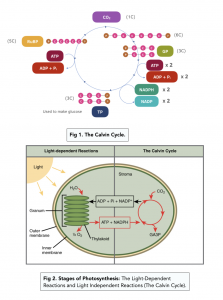The 2 Stages of Photosynthesis (A-level Biology)
The 2 Stages of Photosynthesis
Stages of Photosynthesis
Photosynthesis can be divided into two reactions, which will be outlined below:
Light Dependent Stage of Photosynthesis
The light dependent reactions are the first phase of photosynthesis, and take place in the thylakoid membranes of the chloroplasts.
- Light energy is absorbed from the sun by the plant cells. This excites, and hence releases, the electrons in the chlorophyll, causing them to pass to an electron acceptor at the start of an electron transport chain, a process known as photo-ionisation.
- Redox reactions pass electrons down the chain from one electron carrier to the next. This helps to generate ATP from ADP and inorganic phosphate in a process known as photophosphorylation, which can either be cyclic or non-cyclic. NADP is also converted to reduced NADP
- The light energy splits water molecules into protons (H+), electrons and oxygen (waste). The electrons are used to replace those lost from the chlorophyll in the first step. The process of splitting water bonds is called photolysis. Protons get pumped across the membrane using the ATP created in the previous step in a process known as chemiosmosis, creating a chemical potential gradient.
- Reduced NADP gets generated. This is due to the electrons in the electric transport chain being transferred to NADP along with a proton (NADPH).
- ATP is synthesised. The proton passes back through the membrane with an ATP synthase enzyme, creating a molecule of ATP. It takes around 4 protons to make 1 ATP molecule.
Reduced NADP is a source of H+ for the light-independent stage, whilst ATP is a source of energy.
Light Independent Stage of Photosynthesis
The light independent reactions are the second and final phase of photosynthesis taking place in the stroma of the chloroplasts. The light-independent reactions are collectively known as the Calvin cycle and uses ATP and reduced NADP from the light-dependent stage to produce glucose.
- Carbon fixation occurs. 5-carbon ribulose bisphosphate (5C RuBP) combines with carbon dioxide. The enzyme catalysing the reaction is known as RuBisCo, creating the process known as carbon fixation.
- GP molecules form. The RuBP gets converted into 2 glycerine 3-phosphate (GP) molecules.
- The GP molecules reduce to form other molecules. Reduced NADP and ATP molecules are used to reduce the GP molecules into triose phosphate (TP), also known as glyceraldehyde phosphate (GALP). During this reduction, the reduced NADP becomes oxidised.
- Glucose is produced. Some molecules of TP/GALP are used as a raw material to create glucose, which can then be converted into essential organic compounds. It takes 2 cycles to create 1 glucose molecule. Some of the organic compounds are mono/polysaccharides, lipids, amino acids and nucleic acids.
- RuBP is regenerated. ATP helps to turn the remaining TP/GALP molecules back into RuBP.
The light independent stage cannot function without the products of the light dependent stage (reduced NADP, ATP).

TP, GP and Organic Substances
Both TP/GALP and GP can be used to make organic substances:
- Glucose – 2 TP/GALP joined are together to make glucose and other hexose sugars.
- Starch, Cellulose, Sucrose – Many hexose sugars can be joined to make large carbohydrates
- Lipids – TP/GALP is used to make glycerol. GP is used to make fatty acids. Together they can make lipids.
- Amino acids – GP can be used to synthesise certain amino acids.
FAQs
The two stages of photosynthesis are the light-dependent reactions and the light-independent reactions.
The light-dependent reactions take place in the thylakoid membranes of chloroplasts and involve the absorption of light energy by photosynthetic pigments, such as chlorophyll. This energy is then used to produce ATP and NADPH, which provide energy for the light-independent reactions.
The light-independent reactions take place in the stroma of the chloroplasts and involve the use of the energy from ATP and NADPH produced in the light-dependent reactions. Carbon dioxide is fixed into glucose through a process called the Calvin cycle.
Photosynthesis has two stages because it involves two distinct sets of reactions that occur in different parts of the chloroplasts in plant cells.
The first stage of photosynthesis is called the light-dependent reactions, which occur in the thylakoid membranes of the chloroplasts. In these reactions, light energy is absorbed by chlorophyll and other pigments, and converted into chemical energy in the form of ATP and NADPH. Water molecules are also split in this stage, releasing oxygen gas as a byproduct.
The second stage of photosynthesis is called the light-independent reactions, or the Calvin cycle. These reactions occur in the stroma of the chloroplasts and do not require light energy directly. Instead, the ATP and NADPH produced in the light-dependent reactions are used to power the synthesis of carbohydrates from carbon dioxide in the air. This process is also known as carbon fixation.
By having 2 stages of photosynthesis, it can efficiently convert light energy into chemical energy and use that energy to power the synthesis of organic molecules from carbon dioxide. The light-dependent reactions capture energy from sunlight and convert it into chemical energy, while the light-independent reactions use that energy to build organic molecules that can be used for growth, repair, and energy storage in the plant.
The process of photosynthesis removes carbon dioxide from the atmosphere and produces oxygen as a by-product. This helps to regulate the levels of these gases in the atmosphere, which is important for maintaining a balance that supports life on Earth.
An increase in carbon dioxide levels can increase the rate of photosynthesis in plants. This is because the light-independent reactions of photosynthesis require carbon dioxide as a starting material, so an increase in its availability can lead to an increase in the rate of glucose production. However, too much carbon dioxide can also have negative effects on plants and the overall ecosystem.






Still got a question? Leave a comment
Leave a comment